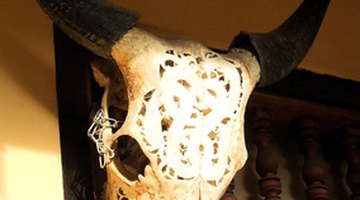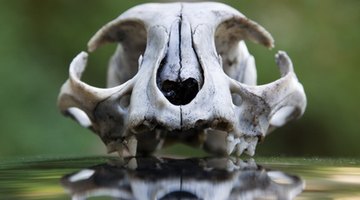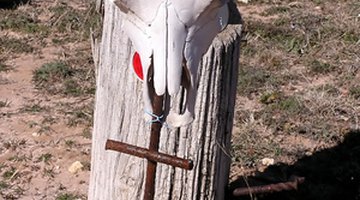How to Paint Skulls
American Indian and other artists use the skulls of animals as a natural canvas. For some this follows a tradition developing since prehistory, when primitive people painted animals on the walls of caves to honor the animals' spirits or to document a hunt. Others paint skulls as decorative or conversation pieces.

Things You Will Need
- Large pot
- Heat source
- Gloves
- Knives
- Spoon
- Tweezers
- Large forks
- Enzyme bleach powder
- Hydrogen peroxide
- Water-based polyurethane
- Paint and brushes
A skull can be painted one color or with intricate designs. You begin by defleshing and sanitizing the skull.
Preparing the Skull
-
Place the head on a stable surface. Use a knife to peel the skin away from the muscle; when you have separated a flap, grip it firmly and pull the skin away. Slice away as much meat as possible and remove the eyeballs with a sharp knife. Place the head in a pot of water large enough to allow movement. Bring to a boil. Turn the head repeatedly with large forks to make sure all of the meat is cooked. If the skull has horns that prevent turning, ladle boiling water over the top of the head continuously. Cook until the meat separates from the bone easily. Remove from water and cool thoroughly.
-
Remove all tissue. Remove the brain with a spoon or knife through the hole where the skull joined the spine. Soak the skull in a solution of cold water and up to a cup of enzyme bleach powder to break down remaining bits of tissue. You can also use hydrogen peroxide. Soak larger skulls for two days, smaller skulls for one day. Remove the skull from the solution and clean away residual tissue with tweezers or a stiff brush. Rinse the skull and let dry to the touch.
-
Coat the skull with a water-based polyurethane in spray or paint form. Apply two thin coats and one thicker coat, allowing each to dry before applying another.

Painting the Skull
-
Draw your design on paper or directly on the skull. Do not draw with a grease pencil, because this will repel paint.
-
Apply paint, following your design or painting free-form. Let each coat dry to the touch before adding more to prevent muddying. Use a fast-drying paint like enamel if you want crisp lines and bright colors. Use a slower drying paint like oil or polymer if you want to blend colors. You can also use stencils and spray paint.
-
Stop and examine your work, giving yourself time to let your imagination flow so that when you're done you can enjoy an unusual art form--a painted skull.

Tip
If you are unable to prepare your skull within a day, freeze the head to prevent decay. Using parts of state or federally protected animals is illegal. Call the nearest Department of Fish and Game or Department of Public Safety to check the regulations before beginning.
Warning
Use disposable gloves when handling the heads of carnivores (meat eaters), because they may contain the rabies virus. Boiling will destroy the virus.
Check out this related video from Homesteady on Youtube.
References
Tips
- If you are unable to prepare your skull within a day, freeze the head to prevent decay.
- Using parts of state or federally protected animals is illegal. Call the nearest Department of Fish and Game or Department of Public Safety to check the regulations before beginning.
Warnings
- Use disposable gloves when handling the heads of carnivores (meat eaters), because they may contain the rabies virus. Boiling will destroy the virus.
Writer Bio
Sandra W. Benally has worked as a professional writer for over 15 years. Her work has been published in "SageWoman," "Fate Magazine," the Native American Journal," the "Navajo Hopi Observer" and "Tutuveni"—the newspaper of the Hopi Tribe. Sandra holds a bachelor's degree in legal studies.
Photo Credits
- Balinese Carved Buffalo Skull image by afroditi from Fotolia.com
- Balinese Carved Buffalo Skull image by afroditi from Fotolia.com
- skull image by bright from Fotolia.com
- cow skull image by Empath from Fotolia.com
More Articles



